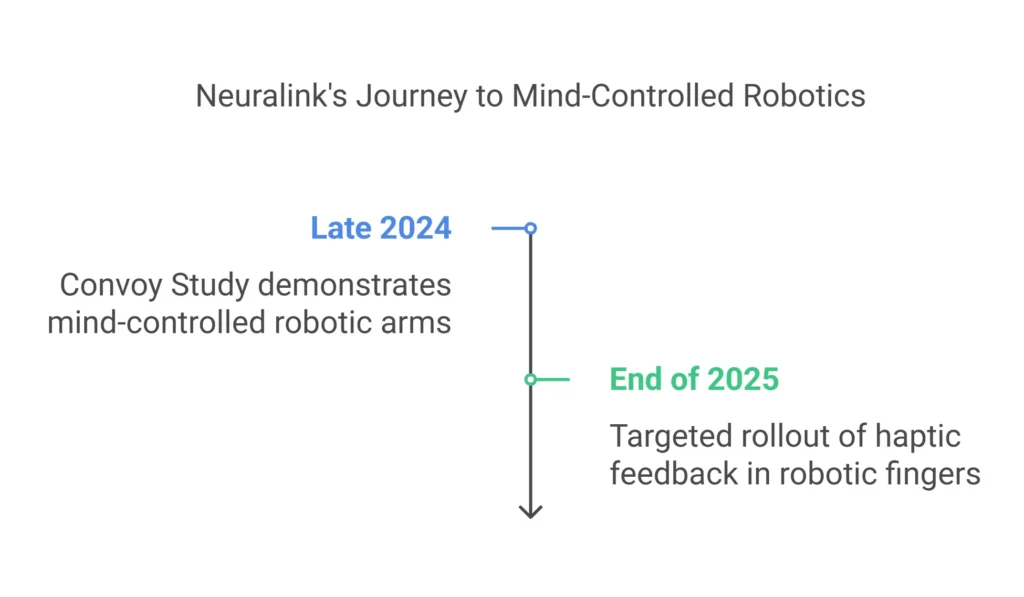With 86 billion neurons, the human brain has been one of the medical fields’ greatest mysteries and a frontier to be explored. In 2025, however, Neuralink stands ready to decode its secrets with the precision of a science fiction story.

Their latest clinical trials are a game changer, and for those dealing with paralysis, it represents a fault line of what is known to be possible.
From Mind to Mouse: The Dawn of Digital Autonomy
Neuralink’s N1 brain implant is now allowing three paralysed patients to access the internet using just their thoughts. The device consists of a coin-sized chip implanted into the skull, which translates neural activity into commands for computers and smartphones.

Take Noland Arbaugh for example. He was left paralysed below the shoulders due to a diving accident, but has now regained the ability to play chess, design 3D models, and even post on social media – all with a cursor controlled by his subconscious intent, as explained in the Neuralink PRIME Study..
Key milestones from the trials: Key milestones from the trials:
- Speed: Participants reach a maximum of 8.0 bits per second (cursor movement) which is twice the previous brain–computer interface (BCI) benchmark published in MIT Technology Review.
- Independence: Patients are reporting 6.5h/day device use and the possible impact of this, including decreases in the number of hours of caregiver support required to complete tasks, like communication or navigating the Internet, as reported by Digital Health News
- Adaptability: Machine learning algorithms can retrain the system, in less than 5 min of time used, in such a way that, even if the pattern of activity undergoes alteration, the continuous control is guaranteed (as The Economic has demonstrated).
Arbaugh, from the perspective of the implant, thinks that the implant is not a tool but a net of safety. It’s almost like the Star Wars game,” he chuckled, showing us how to precisely move a mouse.
The Robotic Surgeon Redefining Brain Surgery
Neuralink’s R1 surgical robot has been the unseen accomplice of this revolution. Developed to cover such electrodes thinner than human hair on top of the motor cortex of the brain, it is powered with sub-millimetre accuracy so that it does not hit the target tissue as reported in the trial reports from The Miami Project. How the R1 works:

How the R1 works:
- Precision Mapping: MRI and in vivo imaging guides the robot toward motile planner neurons..
- Thread Insertion: Tens of thousands two hundred and four electrode-impregnated threads are covered by microns out of the neuron body and it is possible to have high-resolution neural interface
- Rapid Implementation: All stages are performed in 2 hrs (trivial fraction of the timespan used in traditional neurosurgery).
Early hiccups, like electrode retraction in Arbaugh’s case, were mitigated by embedding threads deeper and refining the robot’s motion-compensation software. The result? A 30% drop in post-op complications compared to 2024 trials, as noted in Financial Express.
2025’s Upgraded Implant Neuralink’s 2025 : What’s New?
This year’s N1 chip isn’t just iterative—it’s transformative.
| Feature | 2024 Model | 2025 Upgrade | Impact |
| Electrodes | 400 channels | 1,024 channels | Sharper signal decoding for complex tasks |
| Bandwidth | 100 Mbps | 200 Mbps | Near-instant response for cursor control |
| Battery Life | 12 hours | 18+ hours | All-day use without recharging |
| Calibration Time | 45 minutes | <5 minutes | Reduced downtime for users |
The upgrades stem from a redesigned chip architecture and AI-driven software that predicts neural patterns before they form. “We’re moving from a minivan to an F1 car,” said Bliss Chapman, Neuralink’s BCI software lead, in an interview with MIT Technology Review.
Beyond Cursors: The Convoy Study and Robotic Arms
Neuralink’s ambitions don’t stop at screens. Another study is presented, the Convoy Study (late 2024), which provides patients with robotic arms controlled by the mind. At a recent demonstration, a subject wrote “convoy” using a robotic arm—we describe this for the first time in BCI technology, The Economic Times reported.

Applications in testing:
- Self-Care: Brushing hair, gripping utensils, and adjusting clothing. Creative Work:
- Creative Work: Using CAD software to prototype assistive devices.
- Mobility: Fetching objects across rooms via wheelchair-mounted arms.
Neuralink is targeting a rollout of haptic feedback to a system used for “touching” objects by integrating the sense of pressure into the robotic fingers at the very latest by the end of 2025.
The Global Race for Neurotech Dominance
Neuralink isn’t alone in this space. Here’s how rivals stack up:
| Company | Technology | Edge |
| Neuralink | Robot-implanted threads | Highest electrode density (1,024) |
| Synchron | Stentrode via blood vessels | Non-invasive; FDA-approved since 2022 |
| Blackrock Neurotech | Cortical arrays | 20+ years of human trial data |
While Synchron’s stentrode avoids brain surgery, it lags in signal resolution. Blackrock’s experience is unmatched, but its bulky hardware can’t match Neuralink’s wireless design, per MIT Technology Review.
Ethical Tightropes and Regulatory Hurdles
With great innovation comes greater scrutiny. Neuralink’s trials face three major challenges:
- Data Privacy: Who owns neural data? The Food and Drug Administration (FDA) has been looking for end-to-end encryption, but security vulnerabilities may leave users’ verbatim mental expressions exposed.
- Accessibility: Cost of $500,000/implant the open question lies in whether this developing technology will worsen health disparities. Neuralink claims costs will drop post-approval.
- Longevity: Devices of the first generation can be applied for $2$ years before scar tissue leads to the confounding effect on signal transduction. Newer hydrogel-coated electrodes aim for 5+ years.
What’s Next? Sight, Speech, and Global Scaling
Neuralink’s pipeline is as audacious as the vision of its founder:
- Blindsight: FDA has fast-tracked the trials with the aim of restoring vision through phosphene mapping in the visual cortex, as described in Neuralink’s blog.
- ALS Adaptation: AI models have begun to decode motor intent in patients afflicted with advanced neurodegeneration.
- Global Expansion: Canada’s 6-patient trial and the EU partnership talks could result in 30+ implants in 2026
Final Thoughts Neuralink’s 2025 Trials : A New Era of Autonomy
Neuralink’s 2025 trials aren’t just about gadgets—they’re about rewriting the social contract for paralysis. For the first time, patients can text loved ones, work remotely, or sip coffee unaided. Yet, as Marco Baptista of the Reeve Foundation cautions, “Safety must pace ambition.” The road ahead is fraught with ethical landmines, but the destination—a world where paralysis isn’t a life sentence—is worth the climb.
Curious about joining a trial? Visit Neuralink’s Patient Registry to learn more.
Engage with Us: What’s your take on merging minds with machines? Could BCIs redefine human potential, or do the risks outweigh the rewards? Share your thoughts below.

[…] Neuralink’s brain-computer interface technology raises concerns about neuro-rights violations […]